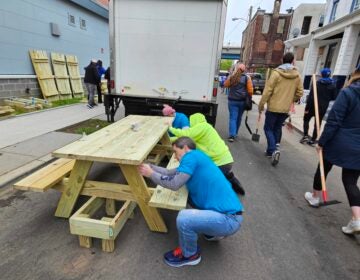Co-housing in Philadelphia gravitates to the Northwest
A group of mostly Northwest Philadelphia residents is looking for a special place to build their dream homes – dream community really.
Designed by the 25 to 40 households that will live there as something of a cross between a condominium association and a commune, the Wissahickon Eco-Village Co-housing community will be the first co-housing development in Philadelphia, as far as organizers can tell.
There are other condominium buildings in the city, and even co-op style apartments where residents share in some communal work, like cleaning the building. But this will be a bit different, according to Lynne Iser and Libby Harman, who organized a recent recruiting meeting for the Eco-Village at the First United Methodist Church of Germantown.
Iser says co-housing is something that came from Denmark in the early 1970s. It’s a planned neighborhood of private homes designed in a way that encourages residents to live closely and spend time together with things like a community house and kitchen for regular community meals and other shared events and chores. Plus each community contains design elements that are important to the people who plan to move in. With the Eco- Village green design is one of those things, she said.
For Libby Harman, who lives in Mt. Airy, and many of the 15 households already planning to pitch their communal tents, Northwest Philadelphia has always seemed a natural place to locate. Recently the plan was to build in Roxborough but that possibility fell through in April. Now the group is looking primarily in the Mt. Airy and Germantown areas.
“We’re in flux in terms of where we’re going to settle but I think there is a pull to the Northwest,” said Harman.
The eleven potential new recruits at last month’s meeting were trying out the idea of co-housing and learning about the parameters of the Eco-Village group. Through Iser and Harman the Eco-Village was also trying them out as possible members.
Ideally, these people would be willing to pony up a hefty sum to begin construction costs – the goal is to pre-sell 70 percent of the units in the development, which will provide homes ranging in size from 750 square feet up to 1800 to 2000 square feet.
A secondary hope is to come across the kinds of people that would fit in with the ethic of co-housing. In short, people who like to share; and people who value ecology and diversity in their lives, organizers said.
There seemed to be some kindred spirits around the church table that night.
Janet Tebble was drawn to the idea of co-housing and was surprised to realize at the meeting that she has always had a certain version of it in her life through the summer cottage at Warrior’s Mark Pennsylvania where her family has always vacationed.
“I had never thought of it as co-housing before but I guess it is,” she said of the rural, 17 home vacation community. The homes have been in the same families for four generations with a tradition of regular community potluck dinners.
Vanessa Lloyd had some co-housing like experiences of her own. She lives in a cooperatively organized apartment building where some facilities and building wide chores are shared. She liked the idea of moving into a co-housing community for a number of reasons, but as the only African American in the group meeting last month she also wanted to be sure the Eco-Village commitment to diversity extended to ethnic and racial diversity.
“One of the things I’ve noticed in my research of co-housing is there’s not a lot of diversity, but there is often a commitment to diversity,” she said.
Meeting organizers explained that every co-housing community is different, and from building architecture, to site layout, to community social expectations, each is directly and painstakingly designed by its member group. This means many things are possible, but it also means time, Iser said, and some measure of risk.
“There is a little bit of faith involved,” she said.
In all Iser estimated about three years before construction would begin on the Eco-Village, assuming the group can find another suitable lot soon.
To Don Bustard, who graduated from Germantown High School in 1947, the idea of co-housing was appealing, especially the part about being in a living, diverse community, but at 81 years old, a three-year wait didn’t sound so great.
“As a retired person and a senior citizen, three years is difficult. With three years, who knows?” He said.
WHYY is your source for fact-based, in-depth journalism and information. As a nonprofit organization, we rely on financial support from readers like you. Please give today.




